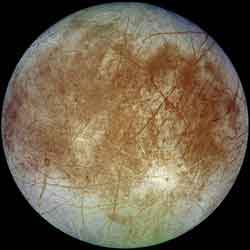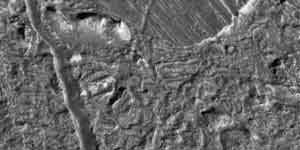- Europa, a Continuing Story of Discovery at NASA/JPL
- The Calendars of Jupiter
|
|
Europa (ew-roe'-pa , Greek Ευρώπη) is a moon of the planet Jupiter, smallest of the four Galilean moons. It is named after Europa, one of Zeus's many love interests in Greek mythology, after whom the continent of Europe is also named. Although the name "Europa" was suggested by Simon Marius soon after its discovery, this name and the names of the other Galilean satellites fell out of favor for a considerable time, and was not revived in common use until the mid-20th century. In much of the earlier astronomical literature, it is simply referred to by its Roman numeral designation as Jupiter II or as the "second satellite of Jupiter".
Physical characteristics Interior of Europa [Source] Europa is somewhat similar in bulk composition to the terrestrial planets, being primarily composed of silicate rock. It has an outer layer of water thought to be around 100 km thick (some as frozen ice upper crust, some as liquid ocean underneath the ice), and recent magnetic field data from the Galileo orbiter shows that Europa generates a sympathetic magnetic field by interacting with Jupiter's, which suggests the presence of a large fluid layer which is likely a salty liquid-water ocean. Europa may also contain a small metallic iron core.
Surface The Europan surface is extremely smooth; few features more than a few hundred metres high have been seen. The prominent markings crisscrossing the moon seem to be mainly albedo features, with very low vertical relief. There are very few craters on Europa (only three are larger than 5 km in diameter), and its albedo is one of the highest of all moons. This would seem to indicate a young and active surface; based on estimates of the frequency of cometary bombardment Europa probably endures, the surface must be no more than 30 million years old. The smoothness and visible markings strongly resemble that of sea ice on Earth, and it is thought that under the surface there is a layer of liquid water kept warm by tidally generated heat. The temperature on the surface of Europa is 110 K at the equator and only 50 K at the poles, however, so the surface water ice is as hard as rock. The largest craters appear to be filled with flat, fresh ice; based on this and on the calculated amount of heat generated by Europan tides it is predicted that the outer crust of solid ice is approximately 10-30 kilometres thick, which could mean that the liquid ocean underneath may be as deep as 90 kilometres.
Approximately natural color image of Europa by the Galileo spacecraft [Source] Europa's most striking surface feature is a series of dark streaks criss-crossing the entire globe. These streaks strongly resemble the cracks that form in sea ice on Earth, and close examination shows that the edges of Europa's crust on either side of the cracks have moved relative to each other. The larger bands are roughly 20 km across with diffuse outer edges, regular striations, and a central band of lighter material which is thought to have been produced by a series of volcanic water eruptions or geysers as the Europan crust spread open to expose warmer layers beneath. The effect is similar to that seen in the Earth's oceanic ridges. These various fractures are thought to have been caused in large part by the tidal stresses exerted by Jupiter; Europa's surface is thought to rise and fall up to 30 meters between high and low tides. Since Europa is tidally locked to Jupiter, and therefore always maintains the same orientation towards the planet, the stress patterns should form a distinctive and predictable pattern. However, only the youngest of Europa's fractures conform to the predicted pattern; other fractures appear to have occurred at increasingly different orientations the older they are. This can be explained if Europa's surface rotates slightly faster than its interior, an effect which is possible due to the subsurface ocean mechanically decoupling the moon's surface from its rocky mantle and to the effects of Jupiter's gravity tugging on the moon's outer crust. Comparisons of Voyager and Galileo spacecraft photos suggest that Europa's crust rotates no faster than once every 10,000 years relative to its interior.
Craggy mountains and smooth plates jumbled together in the Conamara Chaos region [Source] Another type of feature present on Europa are circular and elliptical lenticulae, Latin for "freckles". Many are domes, some are pits and some are smooth dark spots. Others have a jumbled or rough texture. The dome tops look like pieces of the older plains around them, suggesting that the domes formed when the plains were pushed up from below. It is thought that these lenticulae were formed by diapirs of warm ice rising up through the colder ice of the outer crust, much like magma chambers in the Earth's crust. The smooth dark spots could be formed by meltwater released when the warm ice breaks the surface, and the rough, jumbled lenticulae (called regions of "chaos", for example the Conamara Chaos) appear to be formed from many small fragments of crust embedded in smooth dark surface like icebergs in a frozen sea.
Atmosphere Recent observations by the Hubble Space Telescope reveal that Europa has a very tenuous atmosphere (1 micropascal surface pressure) composed of oxygen. Of all the moons in the solar system only six others (Io, Callisto, Enceladus, Ganymede, Titan and Triton) are known to have atmospheres. Unlike the oxygen in Earth's atmosphere, Europa's is almost certainly not of biologic origin. It is most likely generated by sunlight and charged particles hitting Europa's icy surface producing water vapor which is subsequently split into hydrogen and oxygen. The hydrogen escapes Europa's gravity due to its low atomic mass, leaving the oxygen behind.
Subsurface ocean The Galileo orbiter has found that Europa has a weak magnetic field (about one quarter the strength of the Ganymedean field and similar to Callisto's), and, most interestingly, it varies periodically as it passes through Jupiter's massive magnetic field. On March 2, 1998 NASA announced that Galileo had uncovered very strong evidence that there is a conducting material beneath Europa's surface, most likely a salty ocean. Spectrographic evidence suggests that the dark reddish streaks and features on Europa's surface are rich in salts such as magnesium sulfate (Epsom salt), deposited by evaporating water that emerged from within. However, since these salts are colorless or white when pure, some other material must also be present to account for the reddish color. Sulfur or iron compounds are suspected. It has been suggested that life may exist in this under-ice ocean, perhaps subsisting in an environment similar to Earth's deep-ocean hydrothermal vents or the Antarctic Lake Vostok. There is currently no supporting evidence for this hypothesis, but efforts have nevertheless been made to avoid any possibility of contamination. The Galileo mission was concluded in September 2003 by crashing the spacecraft into Jupiter —if simply abandoned, the unsterilized craft might have eventually crashed into Europa and contaminated it with terrestrial microorganisms. The introduction of such microorganisms could make it impossible to determine if Europa ever had its own native life, or could even destroy such life if it exists.
Exploration of Europa Most of our knowledge of Europa comes from the flybys by the Voyager and Galileo missions. Various proposals have been made for future missions, but the only serious proposal, the Jupiter Icy Moons Orbiter, has been rendered unlikely by recent budget cuts. More ambitious ideas have been put forward to explore the possible ocean beneath Europa's ice. One proposal calls for a large nuclear powered "Melt Probe" which would melt through the ice until it hit the ocean below. Once it reached the water, it would deploy an autononomous underwater vehicle, which would gather information and send it back to Earth. This proposed mission has not yet reached a serious planning stage.
Europa in popular culture
See also
Links
... | Io | Europa | Ganymede | ...
Jupiter's natural satellites Inner satellites | Galilean moons: Io, Europa, Ganymede, and Callisto | Themisto | Himalia group | Carpo | S/2003 J 12 | Ananke group | Carme group | Pasiphaë group | S/2003 J 2 Retrieved from "http://en.wikipedia.org/"
|
|
|||||||||||||||||||||||||||||||||||||||||||||||||||||||||||||||||||||||||||



